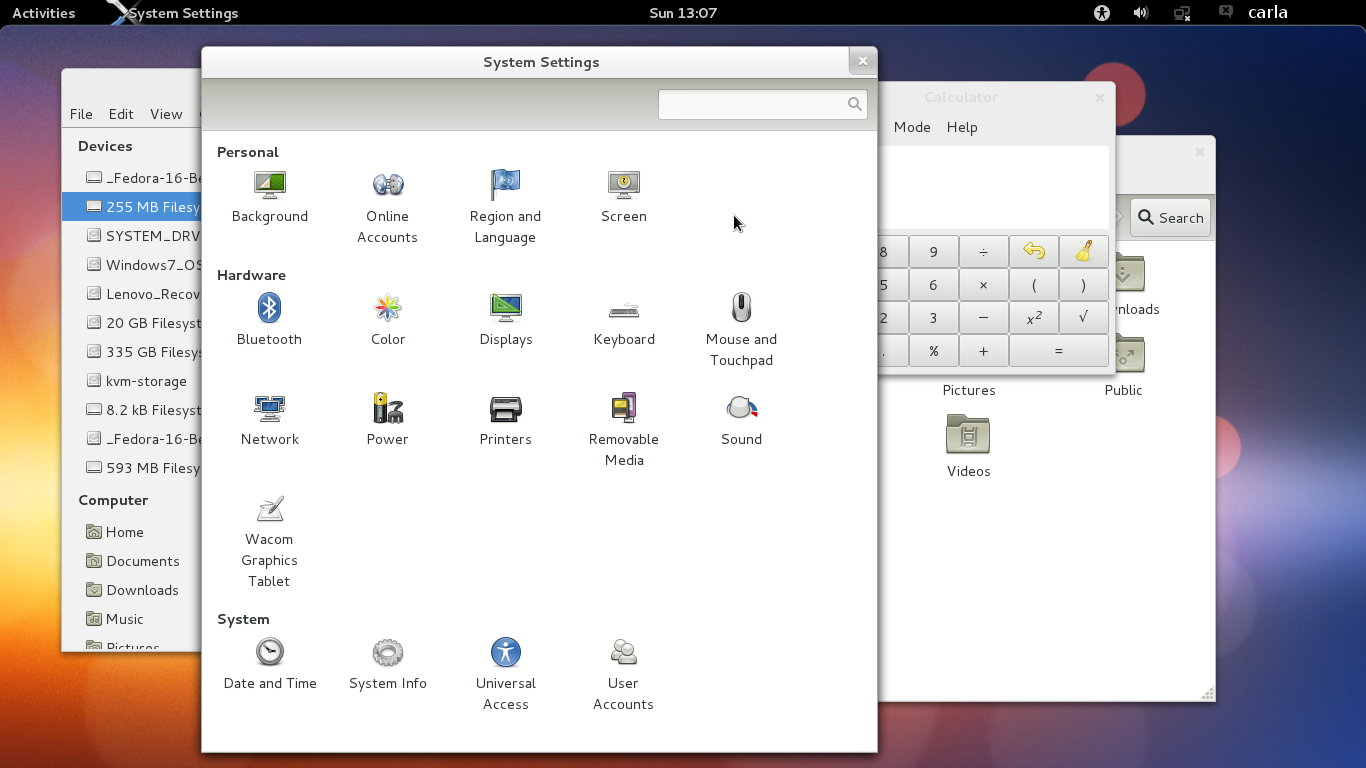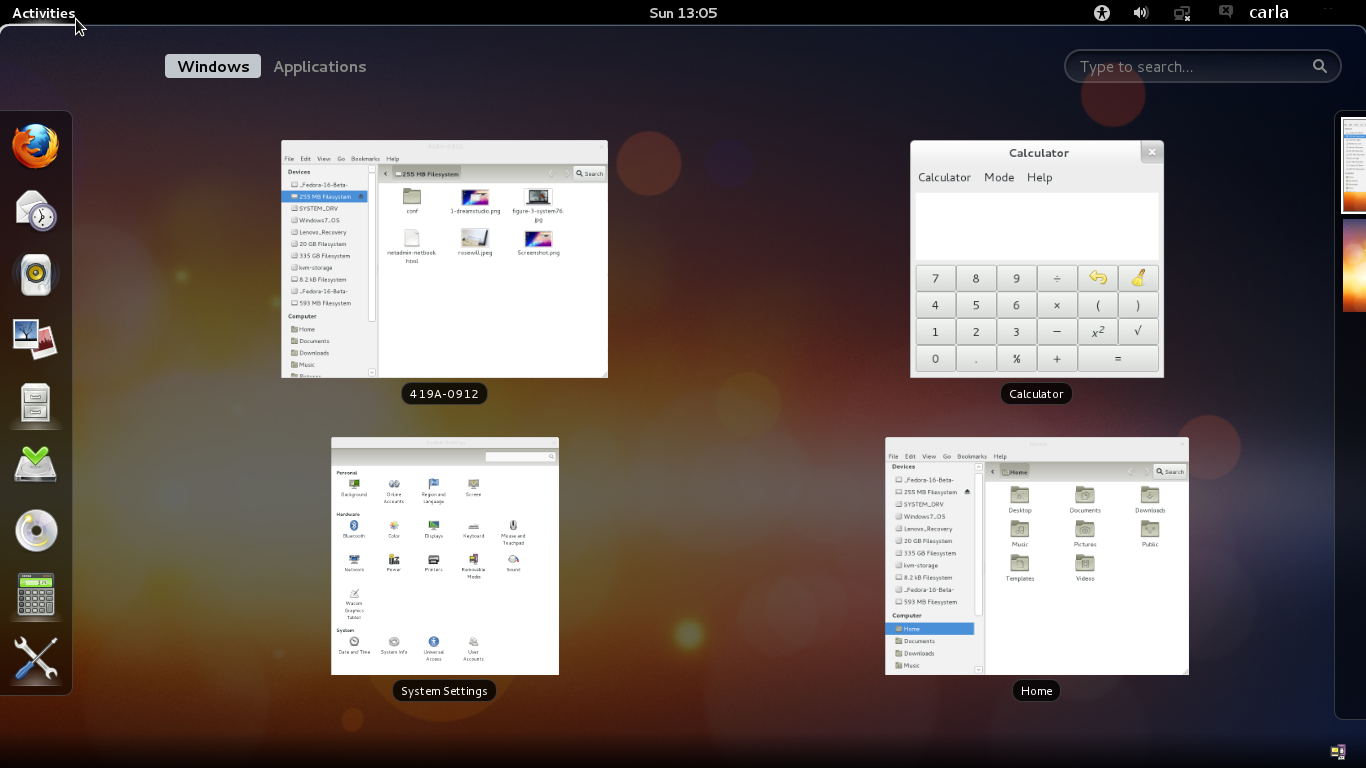Fedora Linux is always pushing the bleeding edge, and has evolved into a versatile, flexible distro with something for everyone, for little old ladies with netbooks to students to powerhouse enterprises. Fedora 16, Verne, is due to be released November 8, 2011, so let’s take a sneak peek at what’s inside.
New Goodies Galore
Fedora 16 is code-named Verne, for Jules Verne. (If you haven’t read Verne his works are still widely available, and are even on Kindle and Nook. Treat yourself; they’re wonderful.) I tested the Fedora 16 beta, released on October 4th.
Fedora is both a great testbed for new technologies, and a good distro with a strong commitment to free (as in freedom) software. Fedora was the first, or among the first to roll out SELinux, a free Java environment (GNU Java, OpenJDK, and ecj) back before Sun’s Java was converted to the GPL, PulseAudio, and Nouveau. Adam Williamson, Fedora’s QA Community Monkey, explains:
“Fedora isn’t only a test bed, it is a perfectly usable distro as a daily driver. It is going to be slightly less dependable and polished than Ubuntu for such use, in general. Everyone has a slightly different take on Fedora but I like to see it as being kind of a prototype, or maybe a first-year model; it’s not exactly that we’re not trying to build an awesome usable desktop / server distro, but we tend to introduce a lot of very Shiny New Stuff and do it on a very aggressive schedule. And of course we don’t provide any non-free drivers or worry overmuch about making sure they work, which can be a consideration. I run the next-stable-version on my desktop most of the time and it’s totally workable, and I run my servers on current-stable-Fedora. But there may be the odd occasion where something breaks, and version upgrades can be a bit bumpy.”
F16 introduces a number of significant changes: GRUB 2 replaces legacy GRUB, HAL is gone and replaced by udisks, upower, and libudev, migration from SysV init to native Systemd continues (scheduled for completion in F17), and a number of cloud utilities and OpenStack are included. btrfs, the much-hyped filesystem that is supposed to become the Linux default, was supposed to be the default for Verne, but it’s still not ready.
The main snag is the lack of a dependable, fully-functional fsck, so look for it in F17. You can still use it if you like because it is an option in the installer when you set up partitions. And, as Adam Williamson revealed, “btrfs has been available as a Sekrit Option in the installer for several releases, you make it available by passing a kernel parameter to the installer. For a while this was, awesomely, ‘icantbelieveitsnotbtr’, but now it’s just plain ‘btrfs’.”
A big change is moving to the GUID Partition Table (GPT), which replaces the familiar but no longer adequate MSDOS disklabels used by the MBR (master boot record) partitioning scheme. The MBR is limited to four primary partitions and as many as 59 extended partitions, depending on which kernel version you’re running, and a total maximum disk size of 2.19 TB. The GPT supports disks larger than 2.19 TB and a minimum — yes, you heard me, a minimum of 128 partition table entries, with none of this primary and extended guff, but all the same kind. GPT is part of the Unified Extensible Firmware Interface (UEFI) specification, which is replacing the aging and creaky BIOS we’ve been butting our heads against for years. Legacy GRUB does not support GPT or UEFI, except for Fedora’s version which includes efi-gpt patches from Intel.
The cloud components are a big deal, and not just because cloud is the newest buzzword. Storage and server management have long traditions of being overpriced and unnecessarily difficult; the cloud is a game-changer because it is flexible and efficient, and built on open technologies. IT managers have learned from hard experience that openness is very much to their benefit.
F16 includes the Condor IAAS (infrastructure as a service) Cloud, the Aeolus Conductor, which is a nice Web-based cloud manager, and OpenStack, the open cloud computing platform that is supported by over 130 businesses worldwide, including SUSE, HP, Dell, and Canonical. What about Red Hat, the sponsor of Fedora? Red Hat is a not a member of the OpenStack project, but they just bought Gluster, which is, and bundling OpenStack in Fedora could be a sign of their future direction.
GNOME 3
Fedora 16 ships with GNOME 3.2. There is no GNOME 2.x option. I’m not crazy about GNOME 3.2, but I find it more useful than Unity. It’s easier to find applications, and you can easily customize the Activities menu, which is like the left-side dock in Unity, with a quick right-click on the application icons.
The System Settings dialog is accessible from the user menu in the top-right panel, which would be exciting if there were more than a token selection of system configurations. For example, will the day ever come when touchpads can be permanently disabled with a checkbox? Where did the screensaver configuration go? Where is the top panel configuration?
I don’t care for the way everything jumps around; it’s like it was designed by kids raised on MTV. The icons in the Activities dock resize themselves when you make additions and removals. Application windows behave weirdly if you’re not in the right view. For example, trying to vertically scroll in the file manager in the Activities > Windows view makes the file manager shrink. Excuse me for trying. Then it doesn’t stay shrunken, but returns to its original size when you let go. In the Activities view all of your open windows convert to large, uniformly-spaced icons, and a desktop switcher appears on the right in a panel four times too tall. Which suggests you can elect to have more than two virtual desktops, but I couldn’t figure out how. (Figure 1.) The Activities dock disappears every time you launch an application, which is symptomatic of a GUI disease that drives me buggy: the assumption that I only want to ever do one thing at a time.
There is no way to minimize windows, which leads to a cluttered desktop (Figure 2.) GNOME’s oft-stated goal is to reduce clutter. Whatever.
Fortunately, there are multiple spins of Fedora that come with different desktop environments.
The Many Spins of Fedora
Fedora has evolved from its humble beginnings into a multi-featured, community-driven distro that comes in several versions, or spins. The official spins, in order of popularity, are:
- KDE
- LXDE
- XFCE
- Electronic Lab
- Security Lab
- Games
- Design Suite
I would love to talk about these some more, but I am already nattering on too long. Of course you may investigate them for yourself. Currently the LXDE and Electronic Lab spins are getting a lot of favorable attention.
Installation Niceties
The Fedora installer has some nice touches missing in Ubuntu and Debian. Number one is you can configure a wireless interface during installation. No, you cannot do that in Debian or Ubuntu or Linux Mint, or in a number of other Debian derivatives, not even in this glorious year 2011 of the new millennium.
Fedora also offers the option to install the bootloader to the new Fedora partition, instead of overwriting the Master Boot Record (MBR), which Ubuntu insanely insists on doing. This is especially a problem with GRUB 2 because it no longer supports an independent boot partition like legacy GRUB, but instead must sit on top of the Linux it was installed from. Legacy GRUB was not tied to any particular installed operating system, so you could set it up and then install and remove OSes all you wanted without having to babysit GRUB.
The installer offers advanced user configuration such as group memberships and network authentications, and adding additional users.
Pretties
The new artwork is, as always, beautiful and high-quality. The default desktop background is a worthy tribute to Jules Verne.
And that, my friends, is the end of our whirlwind Fedora 16 Verne tour, a high-quality distro dedicated to free software and progress.






